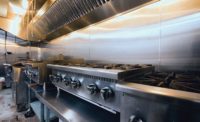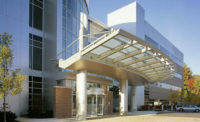Many methods await when it comes to reducing exhaust rates. Fortunately, engineers can avail themselves of multiple tactics, from the hood specification to proper commissioning and air balance.
Part 1 of this series discussed optimizing outdoor air and optional dedicated makeup air for commercial kitchen exhaust systems. This article offers suggestions for optimizing exhaust airflows and introduces a velocity theory of hood operation by which performance of hood configurations and accessories such as end panels can be compared for like appliances and cooking loads.
Minimizing exhaust hood airflow
Beginning with the energy crises in the 1970s, restaurant chains have pursued reducing kitchen exhaust rates to reduce energy for exhaust fans and tempering makeup air while retaining acceptable exhaust hood performance. This article describes several techniques for reducing cooking exhaust rates:
• Specifying aerodynamic hoods;
• Adding hood end/side panels;
• Providing greater hood overhangs;
• Closing gaps behind appliances;
• Avoiding use of single island hoods;
• Optimizing appliance placement;
• Adding demand control kitchen ventilation (DCKV) systems;
• Properly commissioning and testing exhaust systems; and
• Providing and periodically verifying proper air balance.
Aerodynamic Hoods. The smoother the flow into and within exhaust hoods, the better the capture and containment performance. For wall canopy hoods, the Coanda Effect causes rising cooking effluents to move toward the backs of hoods as shown in Figure 1. To take advantage of this effect, well performing hoods provide smooth entrances into hoods and filters without interferences such as offsets.
Aerodynamic hood designs include many other beneficial features, such as a rear standoff for clearance to combustible construction, mechanical baffles to direct circulating effluent back toward filters, and highly efficient grease filters.
End Panels. References 1 through 3 summarize tests of adding end panels to hoods to reduce exhausts. Reference 1 reported that installation of end panels to hoods improved hood performance in static conditions by 10% to 15%, and in dynamic conditions, such as robust cooking with cross drafts, exhausts were reduced up to 35%. The worth of end panels can also be evaluated with the velocity theory of hood operation, sidebar example 2, below. Effective end panel configurations include triangular quarter end panels and tapered full length vertical panels with insulated double walls to reduce heat transfer from cooking.
Note also that demanding fume hoods are provided with fully closed sides, which are comparable to full end panels on exhaust hoods.
Overhang. Given the horizontal variability of cooking effluents as they rise from appliances to hoods, greater hood overhangs over appliances increase the probability of capturing and containing effluents. Reference 3 tested increased front overhangs for light, medium, and heavy duty appliance lines, whereby exhaust requirements were reduced by 9% to 27%.
Importantly, from fire analyses by the author, greater overhangs also help assure that cooking fires are contained in the hood area protected by the fire suppression system. Table 1 provides suggested hood front and side overhangs for popular appliances under wall canopy hoods.
Note that codes typically allow reduced side overhangs if hood ends are closed, such as with full end panels. Hood front overhangs should be greater for more robust appliances and appliances with opening doors. Significantly, hoods with greater overhangs are one time investments that increase capture performance perpetually.
Gaps behind appliances. Hood performance can be increased by pushing appliances as close to back walls as possible. Closing these gaps, such as with metal baffles, will reduce extraneous airflows entering hoods from behind appliances, which otherwise add to the quantity of air that must be exhausted. To facilitate moving appliances rearward, appliance utility pipes, hoses, and power outlets should be installed as close to back walls as possible or inset to not extend forward of back walls.
Single island hoods. Single island hoods are not recommended. In a test summarized in Reference 2, a particular wall canopy hood required 300-400 cfm/ft exhaust with heavy duty cooking appliances. When the same appliances and cooking were tested with the same hood mounted as single island, an exhaust rate in excess of 700 cfm/ft was required to achieve capture and containment. See also example 3 in the velocity theory sidebar.
Appliance placement. In Reference 3, gas fryers and griddles, and electric ovens on stands, were tested singly and in combinations under a 10-ft long wall canopy hood to evaluate the effects of appliance placement. The study confirmed that it’s best to place heavier duty appliances in the middle of cooking lines and lower duty appliances at ends of cooking lines. The tests also confirmed that taller appliances at ends of hoods function as virtual end panels.
Taller hoods. Listed industry standard wall canopy hoods are typically 24 or 30 in tall. Where there is vertical space available, taller hoods have larger reservoirs and will better accommodate surges of cooking effluents such as from opening steamer and oven doors and placing baskets of fries in deep fat fryers.
Demand control kitchen ventilation. The idea of reducing kitchen exhaust during periods of reduced cooking has been pursued for decades, including via manual adjustments of multi-speed exhaust fans. Now, modern DCKV systems include electronic sensors, variable speed exhaust fans, and solid-state controls.
DCKV systems can also match reductions of exhaust air with reductions of dedicated makeup air, which can reduce energy for tempering makeup air proportionally. Because of the cubic relationship of centrifugal fan energy to fan speed and flow rate, reductions of fan speeds provide mathematically larger percentage reductions of fan energy. For example, reducing fan speed and exhaust rate by 20% provides a theoretical fan energy reduction of 49%. Figure 5 shows 24-hr exhaust profiles of a restaurant retrofitted with DCKV, showing the original exhaust rate before retrofit, optimal 100% exhaust rate for measured peak cooking load, and actual exhaust rate with DCKV system controlled by exhaust temperature sensed electronically at exhaust duct entrance.
Modern DCKV systems can also automate startups of exhaust fans in response to cooking appliances being turned on as typically required by mechanical codes. DCKV systems often control operation with variable frequency drives and inverter duty AC motors as illustrated in Figure 6.
Hood commissioning and performance testing
A reasonable guideline for setting exhaust rates is beginning with the UL listed exhaust rate for the average of appliance duties. Then, with full load cooking on all appliances, increase exhaust rates for full capture and containment of effluents.
Commissioning must include performance tests of each hood in accordance with IMC section 507.16 or similar requirements. The test should be run with all appliances at cooking temperatures and all supply and makeup fans on with building doors and windows closed. Hood capture and containment should be evaluated by visual means, such as with artificial smoke puffers, smoke candles, or similar devices.
Air balance
After hood performance has been verified, using the air balance schedule in the building design drawings, it’s important to obtain an initial certified air balance. Thereafter, air balance should be checked and adjusted periodically, particularly if operational changes required airflow changes.
From an engineering viewpoint, negative building pressure adds to the static pressure of exhaust systems, and depending on exhaust fan operation and the applicable fan curve, negative pressure can reduce the exhaust flow rate and diminish exhaust hood performance. See Reference 4 for additional information on the effects of commercial kitchen pressure on exhaust system performance.
A slightly positive design air balance is recommended, such as 300-500 cfm for average-sized restaurants. Among other benefits, this will make doors easier to open, unlike the restaurant in the accompanying photo, with professional lettering on the front door advising customers to “pull hard” because the overall air balance is negative. ES
References
1. Brohard, G. et al. 2002. Makeup Air Effects on Commercial Kitchen Exhaust System Performance. Public Interest Energy Research. California Energy Commission, Sacramento, CA
2. Swierczyna, R. and Sobiski, P. 2010. Island Hood Energy Consumption and Energy Consumption Strategies. ASHRAE Research Project 1480. ASHRAE, Atlanta, GA
3. Swierczyna, R. et al. 2006. Effects of Appliance Diversity and Position on Commercial Kitchen Hood Performance. ASHRAE Research Project 1202. ASHRAE, Atlanta, GA (and supplemental report)
4. Swierczyna, R., Fisher, D., and Horton, D. Effects of Commercial Kitchen Pressure on Exhaust system performance. ASHRAE Transactions 2002, V. 108, Pt. 1. ASHRAE, GA
Image Credits:
Figures 1-3, 5-7, and Table 1 courtesy of CaptiveAire Systems, Inc. Figure 4 is from Wikipedia Commons.












